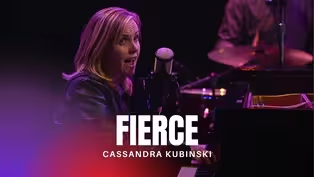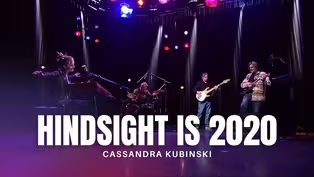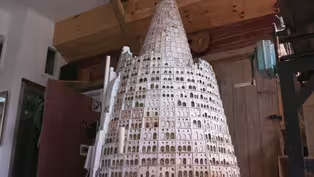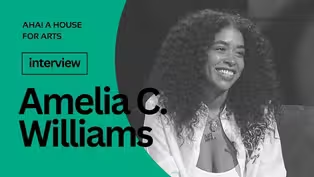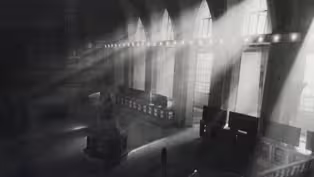
Uncovering Forgotten Art: Photogravure and The Lovebugs
Season 9 Episode 23 | 28m 45sVideo has Closed Captions
Explore photogravure, Love Bug art, and Cassandra Kubinski's music in this artistic journey.
Join us on "AHA, A House for Arts" as we delve into the intricate world of photogravure with Lothar Osterburg, explore the captivating The Lovebugs-inspired pop art installations of Amelia C. Williams, and enjoy heartfelt performances from Cassandra Kubinski's EP, "The Saratoga Sessions." Discover the beauty of these unique art forms and the passion behind them.
Problems playing video? | Closed Captioning Feedback
Problems playing video? | Closed Captioning Feedback
AHA! A House for Arts is a local public television program presented by WMHT
Support provided by the New York State Council on the Arts (NYSCA), M&T Bank, the Leo Cox Beach Philanthropic Foundation, and is also provided by contributors to the WMHT Venture...

Uncovering Forgotten Art: Photogravure and The Lovebugs
Season 9 Episode 23 | 28m 45sVideo has Closed Captions
Join us on "AHA, A House for Arts" as we delve into the intricate world of photogravure with Lothar Osterburg, explore the captivating The Lovebugs-inspired pop art installations of Amelia C. Williams, and enjoy heartfelt performances from Cassandra Kubinski's EP, "The Saratoga Sessions." Discover the beauty of these unique art forms and the passion behind them.
Problems playing video? | Closed Captioning Feedback
How to Watch AHA! A House for Arts
AHA! A House for Arts is available to stream on pbs.org and the free PBS App, available on iPhone, Apple TV, Android TV, Android smartphones, Amazon Fire TV, Amazon Fire Tablet, Roku, Samsung Smart TV, and Vizio.
Providing Support for PBS.org
Learn Moreabout PBS online sponsorship(uplifting music) (chill techno music) - [Matt] Learn about photogravure with Lothar Osterburg.
Explore the mixed media pop art of Amelia Williams.
♪ Don't you know don't you know don't you know ♪ ♪ That it's feels- ♪ And catch a performance from Cassandra Kubinski.
It's all ahead on this episode of "Aha, A House for Arts".
♪ No no no no ♪ - [Narrator] Funding for "AHA" has been provided by your contribution and by contributions to the WMHT Venture Fund.
Contributors include, the Leo Cox Beach Philanthropic Foundation, Chad and Karen Opalka, Robert and Doris Fischer Malesardi, and the Robison Family Foundation.
- At M&T Bank, we understand that the vitality of our communities is crucial to our continued success.
That's why we take an active role in our community.
M&T Bank is pleased to support WMHT programming that highlights the arts and we invite you to do the same.
(upbeat music) (upbeat music fades) - Hi, I'm Matt Rogowicz, and this is "Aha, A House for Arts", a place for all things created.
Today we're gonna take a look back at one of my favorite studio visits, featuring artist Lothar Osterburg.
Now, one of the things I really love about this piece is the music, which was composed by Lothar's wife, Elizabeth Brown.
Take a look.
(gentle violin music) I'm in Red Hook, New York at the studio of Lothar Osterburg to learn more about the intricate process of Photogravure and to learn more about how Lothar uses it in his work.
But first, I need to find where he is.
No way.
That is awesome.
You are inside the Tower of Babel.
- Hello.
Nice to meet you.
- Nice to meet you.
(violin music continues) - [Lothar] I am an artist working in printmaking, photography and sculpture and in various orders of those combinations.
I never loved photography in art school because it always looked to me like it was just surface and the surface just didn't interest me.
And I loved the ink of printmaking.
I loved paint, I loved the tactility of making art.
And when I first learned photogravure, photography suddenly had that tactile quality for me and I just suddenly fell in love.
So, I have a plate here.
Photogravure is a 19th century photographic printmaking process, that etches a continuous tone image into a copper plate and then is inked up and printed like a regular etching onto rag paper where you have a very deep, rich black in the shadows and very shallow, very light, transparent ink layers in the highlights and the mid tones.
So it's a really rich, beautiful, old printmaking process that very few people are doing.
(violin music continues) It's just an amazing experience.
Sometimes really nerve wracking too, but looks good to me.
(violin music) My process does involve probably way more processes, way more steps than absolutely necessary.
But I just love the journey there and all the derailments that you could have along the way.
I start building my models, whatever they may be, like the tower of Babel.
Then I just traditionally stage it, photograph it, sometimes in the studio with studio lighting, sometimes outside.
I bring them out and build them into the landscape and incorporate them.
Once I have the photograph, I then start making decision which ones to print.
And I print all my photographs in the 19th century photographic process of photogravure.
(violin music continues) So I build my models basically of anything that sort of comes to mind and anything that kind of inspires me.
Most of the times it is something that has been sitting in my memory for a while, something that was inspired by reading a book and some image popped up, an image that of course, has something to do with my own experience, but is becoming more like a universal experience.
It's much more also the idea of the emotional memory than a specific memory.
It's not like seeing the pyramids in Egypt for the first time, but the mood that I was in and the kind of all I was in when I first saw them, the scale of it's like, oh my God.
And to capture that, it's not just taking a snapshot or taking a photo or trying to replicate it, but it's also to get some emotional thing in there.
The materials could be very much that I'm on the beach and I see some kid building a sandcastle and say, "Oh my God, I could make my pyramids out of sand", or my museum out of sand, which I actually did, which I also built out of snow.
And here it is out of plaster.
So I then play with the material, see like what does the different material do, maybe to a singular idea or subject or model.
The tatami mats, I'm in the middle of weaving.
I got inspired by walking, trying to identify all the grasses out in our meadow and realizing that some of the grasses are in fact the grasses that they make the real tatami mats out of.
And then I found a smaller version of the same family of grasses that works in the scale I wanted to work in.
And I've kind of built my own loom for those, kind of figured out how to weave it in the scale I needed them.
So it's also for me the process of learning how is something even done.
So, and even if it's becomes a little weird and not off, it's actually, it's good.
It's good for what I want.
If you build a model that is perfect, it looks like a model, once it gets worn, then there is life.
In the piece and in our world around us, and the awe is because those pyramids have been eroded and kind of are no longer the at the original glory.
(violin music continues) When I said earlier, my final product was a photograph or a photogravure, that actually has been changing too.
I had a show where I was placing models behind the wall with lenses with magnifying glasses or lenses in the wall embedded, with a lens it looked like you looked through the viewer of a camera, except when you move around it's actually, you see it's 3D.
And that was a really amazing experience.
So I've started building more of those, including them in little boxes that are movable.
When I said earlier, like I'm a print maker, photographer and sculpture, it it seems right now I feel like I'm more like primarily a sculptor right now, than a photographer and than a print maker.
So it's, it's sort of reversed in the priority in the order.
But I think that's gonna constantly shift anyway.
(violin music continues) - After a start in the fashion industry, Amelia Williams turned back to visual art, creating immersive street inspired pop art installations.
What does that mean?
Let's find out with Jade Warrick.
- Welcome Amelia to House for Arts today.
- Hi, thanks for having me.
- Before we dive in deep to some of your installations and your work you're doing now, I wanna give the audience a little bit of background about who you are as an artist.
- Yeah, so I worked in the fashion industry for about 15 years.
I got my bachelor's degree in computer graphics and new media at the School of Technology in Johnson Wales, Providence, Rhode Island.
What up?
And after that I moved to Los Angeles and I pursued a career in fashion.
And I first started out doing a lot of graphic design for branding, marketing and then went into some design work and eventually went into styling and creative direction and production.
- Oh wow.
It's a lot.
- Yeah.
- And what about that brung you joy?
Because I know you're not into that field so much anymore.
So what kind of brought you out of it a little bit?
- (laughs) I mean, I wouldn't say it brought me joy, which is why I left it.
(laughs) Yeah, it was what I thought I wanted to do.
I think some of it was kind of an ego move, where I felt cool working in the fashion industry and also just innately, I always loved photography and I always loved storytelling through that medium.
So I felt like working on campaigns and being in the industry and working up towards doing a lot of like creative direction and things like that, that would be my outlet for my artistic abilities.
But the further I got into it, I just felt more and more disillusioned by the industry.
I was discouraged by a lot of the things that I would be hearing or experiencing myself.
It's very toxic environment, just inherently, I think because it's based on beauty and selling things based off of looks like to a specific demographic.
It's just, it comes with a lot of backlash to the people who are working on set and even behind the scenes like in production and in the factories and things like that.
But I ended up leaving the industry or trying to leave the industry (laughs), during COVID 2020, 'cause I was styling at the time, but there was no events happening.
So that was a moment where I felt like I could reevaluate everything, which I think a lot of us did collectively as a human race.
And that is what eventually brought me back to art, which is my roots, but more specifically using painting as a diary.
And that was kind of like the beginning of the end for fashion for me.
- It's like the Phoenix, you know, the rebirth.
- Yeah, exactly.
- So I know you focus a lot on mood boards, that's something that's a big focus in your work.
Can you give us a little bit of background about how mood, what are mood boards and how do they integrate into your current work?
- Yeah, it's just pulling imagery from different sources and putting it into one space, to create a mood or a theme or a vibe.
And most fashion projects, even video movies, all start based off of a mood board.
So that was always my favorite part of the process.
I love the creative process, I love research and development and I love getting inspiration from random different places.
So when I started the Love Bugs, which is kind of like my focal project, I first was thinking of doing a cartoon or comic with it.
And so I did what I normally would do with any project or business that I'm working on, and I started with a mood board.
- Give us a little bit more of a background of like, what is this installation or collection and how did you come to it?
- So I have a lot of attachment issues (laughs) or I did, I'm healing, but during one specific bad breakup, I just, it felt like kind of, I think more emotional and bigger than it really needed to be.
And when I was talking to my mom about it, she just explained the science behind the chemicals that we release when we are around someone for an extended period of time, especially that theme and that idea just stuck with me.
And so when I started to get back into painting, I really wanted to use that as just a way to connect with people.
And the Love Bug is kind of like a kitschy little way of being like, you know, it bites you and then suddenly that is the drug that enters your veins and then they take control and kind of like, go into your brain and have full control over your body.
And so as I started to develop the ideas, I was like, I don't really wanna be boxed into just doing a cartoon or just doing animation.
And I kind of wanted to go backwards, where I wanted to use this idea or theme and create mood board based off of that and make each piece very authentic to what I was feeling in that moment.
And instead of trying to stick to one medium, I just kind of was like, okay, today if I feel like doing photography, I will like use this theme and shoot something that feels inspired by the Love Bugs.
And then over time I started to put a lot of pieces together that were either collages or paintings or photography.
Like I said, I did do an animation as well.
And for my first show I ended up putting all of the pieces in one space.
And it was really cool to see, because just naturally they felt cohesive and together, even though a lot of the pieces were very different from each other, but the theme was throughout.
And so it was just an immersive life-sized mood board that people could be inside of.
- Where can folks see this installation?
Are you gonna have it traveling soon or-?
- Yes.
So I am planning, I like to do kind of like little surprise popups for the art shows and have them in not traditional spaces, 'cause galleries don't feel natural to me.
I like to feel like you can feel comfortable in this space.
- Yeah.
- And I like to also incorporate other bipoc artistry in my shows in different ways while highlighting the collection.
But yeah, so I'm also, I'm working on another project that's kind of branching off of the Love Bugs, which will be traveling throughout the Hudson Valley, but that will be more engaging where it has the pieces it, it will pull some pieces from the collection to use as inspiration for people.
And then I'll have an art bar where people can engage and create their own work based off of prompts that I provide.
And the fun part for me is I'm also gonna offer a lot of interesting parts from my collection that aren't necessarily traditional studio art pieces or mediums or work that people can also play with.
So it's like, I'm very tactile, so I like to use my hands and play with things.
- Yeah, it's kind of like communal too.
- [Amelia] Yeah, exactly.
- And it's like mental health as well.
- [Amelia] Yeah.
- Because again, we all kind of deal with love and heartbreak.
- [Amelia] Yeah.
- And it's nice that you're providing a space for people to kind of like express it in a way without judgment.
- [Amelia] Exactly.
- And those kind of guidance with the prompts and things like that.
- Yeah.
- That's awesome.
- Yeah.
- So where can compelled people follow you?
What's your Instagram real quick, so people can follow you so they can see the next art parlor you have going on?
- It's AmeliaCWilliams_.
(both laugh) - Awesome.
Well thank you Amelia, so much for coming today.
I'm super excited to like see your installation myself.
- Yeah.
Thank you.
(both laugh) - Please welcome back Cassandra Kubinski, playing more songs from her EP, "The Saratoga Sessions".
(gentle piano music) ♪ When the hurricane hit we didn't see it coming ♪ ♪ You said the tide's gonna shift ♪ ♪ It's probably nothing ♪ ♪ How could we have known ♪ ♪ It would overturn our world with every blow ♪ ♪ Crack open our hearts send us back to the start ♪ ♪ Over and over and over again ♪ ♪ It's funny how the rear view ♪ ♪ Can be clearer than what's right in front of you ♪ ♪ Why's it always so true ♪ ♪ You know what they say hindsight is 20/20 ♪ ♪ Hindsight is 20/20 ♪ ♪ Hindsight is 20/20 ♪ ♪ I hope the price we paid is worth the lessons we learned ♪ ♪ A new dream arrived while an outdated life burned ♪ ♪ Dancing in the flame ♪ ♪ I turned and saw your face ♪ ♪ The shape of your heart ♪ ♪ I saw a new start ♪ ♪ Something lost but so much gained ♪ ♪ It's funny how the rear view ♪ ♪ Can be cleared than what's right in front of you ♪ ♪ Why's it always so true ♪ ♪ You know what they say ♪ ♪ Hindsight is 20/20 ♪ ♪ Yeah hindsight is 20/20 ♪ ♪ Hindsight is 20/20 ♪ ♪ It's funny how the rear view can be clearer ♪ ♪ Than what's in front of you ♪ ♪ Why's it always so true ♪ ♪ You know what they say ♪ ♪ Hindsight is 20/20 ♪ ♪ Hindsight is 20/20 ♪ ♪ Hindsight is 20/20 ♪ ♪ Hindsight is 20/20 ♪ ♪ Yeah ♪ (gentle piano music fades) ♪ I don't wanna die ♪ ♪ but my body feels broken ♪ ♪ And my heart has spoken no more ♪ ♪ I know that it's my time ♪ ♪ Because I'm weak the legs and I'm ♪ ♪ Holding my head on the floor ♪ ♪ So I get on my knees and pray ♪ ♪ I don't end this way today ♪ ♪ Give me rebirth and decay ♪ ♪ Oh I crumble to ashes ♪ ♪ Light up the night ♪ ♪ As my wings wrap around me ♪ ♪ Folding in tight ♪ ♪ You thought I was finished ♪ ♪ too late to fly ♪ ♪ But you forgot I'm a legend ♪ ♪ And just like the Phoenix I rise ♪ ♪ I rise ♪ ♪ Mm rise ♪ ♪ I've given all I can ♪ ♪ All I knew how to do to my own self and true ♪ ♪ It's never enough for you ♪ ♪ So now ♪ ♪ I'm commanding the spark ♪ ♪ And by my own hand I start anew ♪ ♪ I don't need permission ♪ ♪ To see what I've been missing ♪ ♪ And to see a grander vision ♪ ♪ Where I'm living free ♪ ♪ I crumble to ashes ♪ ♪ I light up the night ♪ ♪ As my wings wrap around me ♪ ♪ Folding in tight ♪ ♪ You thought I was finished ♪ ♪ Too late to fly ♪ ♪ But you forgot I'm a legend ♪ ♪ And just like a phoenix ♪ ♪ Red and blue and gold ♪ ♪ Spirit never grows old ♪ ♪ With each incarnation ♪ ♪ Every transformation makes me stronger ♪ ♪ Brighter ♪ ♪ Wiser than ever ♪ ♪ Before ♪ ♪ Whoa ♪ ♪ Yeah I crumble to ashes ♪ ♪ Light up the night ♪ ♪ As my wings wrap around me ♪ ♪ Folding in tight ♪ ♪ I thought I was finished ♪ ♪ Too late to fly ♪ ♪ But I forgot I'm a legend ♪ ♪ And just like the phoenix ♪ ♪ I'll rise ♪ ♪ Oh I'll rise ♪ ♪ I'll ♪ ♪ I'll rise ♪ ♪ Like the phoenix ♪ ♪ Yeah just like the phoenix I'll ♪ ♪ I'll rise ♪ (piano music fades) - One, two, One, two, three.
♪ I was curled up sleeping like a baby ♪ ♪ Feeling kinda lazy ♪ ♪ I was tired and shying from the spotlight ♪ ♪ But it felt so not right ♪ ♪ Now I'm coming out of my cage ♪ ♪ Kitty's ready to play ♪ ♪ So give her a stage ♪ ♪ I'm fierce ♪ ♪ Now I'm breaking all the laws yeah ♪ ♪ Now I'm taking out my claws yeah ♪ ♪ Got the glitz around my paws ♪ ♪ I'm fierce ♪ ♪ Now I'm struttin' through my hood yeah ♪ ♪ They be staring like they should yeah ♪ ♪ And it all feels so damn good ♪ ♪ So good to me ♪ ♪ To be fierce yeah yeah ♪ ♪ I'm so turnt up pluggin' into power ♪ ♪ Opening like a flower ♪ ♪ I'm a goddess ♪ ♪ (indistinct) fake it ♪ ♪ Want it so I take it ♪ ♪ Now I will accept nothing less ♪ ♪ Then to hold down the best ♪ ♪ Of this lioness ♪ ♪ It's fierce ♪ ♪ Now I'm breaking all the laws yeah ♪ ♪ Now I'm taking out my claws yeah ♪ ♪ Got the glitz around my paws ♪ ♪ Ah ow ♪ ♪ I'm fierce so I'm struttin through my hood ♪ ♪ They be starin' like they should ♪ ♪ And it all feels so damn go so good to be ♪ ♪ To be fierce yeah ♪ ♪ Now listen ♪ ♪ I'm the queen I'm the queen I'm the queen ♪ ♪ Have you seen have you seen have you seen ♪ ♪ I'm the queen I'm the queen I'm the queen ♪ ♪ Have you seen the queen ♪ ♪ Oh yeah ♪ ♪ I'm fierce ♪ ♪ Now I'm breaking all the laws ♪ ♪ Now I'm taking out my claws ♪ ♪ Got the glitz around my paws ♪ ♪ Oh oh I'm fierce ♪ ♪ Now I'm strutting through my hood ♪ ♪ They be staring like they should ♪ ♪ And it all feels so damn good ♪ ♪ Yeah it all feels so damn good ♪ ♪ Yeah it all feels so damn good good good good good ♪ ♪ Yeah yeah yeah ♪ ♪ Don't you know don't you know don't you know ♪ ♪ That is feels so good yeah ♪ ♪ Don't you know don't you know don't you know ♪ ♪ That is feels so good yeah ♪ ♪ Don't you know don't you know don't you know ♪ ♪ That it feels feels ♪ ♪ Oh ♪ ♪ Break it down here we go ♪ ♪ No no no no no ♪ ♪ No no no no no no ♪ ♪ To be so good to be ♪ ♪ So good to be fierce ♪ (bright music) - Thanks for joining us.
For more arts, visit wmht.org/aha and be sure to connect with us on social.
I'm Matt Rogowicz, thanks for watching.
(upbeat music) - [Narrator] Funding for "AHA" has been provided by your contribution and by contributions to the WMHT Venture Fund.
Contributors include, the Leo Cox Beach Philanthropic Foundation, Chet and Karen Opalka, Robert and Doris Fischer Malesardi and the Robison Family Foundation.
- At M&T Bank, we understand that the vitality of our communities is crucial to our continued success.
That's why we take an active role in our community.
M&T Bank is pleased to support WMHT programming that highlights the arts, and we invite you to do the same.
Cassandra Kubinski Performs "Fierce"
Video has Closed Captions
Clip: S9 Ep23 | 3m 19s | Enjoy a performance by Cassandra Kubinski from her EP "The Saratoga Sessions." (3m 19s)
Cassandra Kubinski Performs "Hindsight Is 2020"
Video has Closed Captions
Clip: S9 Ep23 | 3m 4s | Enjoy a performance by Cassandra Kubinski from her EP "Hindsight Is 2020." (3m 4s)
Rediscovering the Lost Art of Photogravure
Video has Closed Captions
Clip: S9 Ep23 | 7m 12s | Lothar Osterburg revives photogravure, blending photography and printmaking in stunning works. (7m 12s)
'The Lovebugs' Art Finds Beauty in Heartbreak
Video has Closed Captions
Clip: S9 Ep23 | 7m 21s | Explore Amelia C. Williams' immersive 'The Lovebugs'-inspired pop art installations. (7m 21s)
Uncovering Forgotten Art: Photogravure and The Lovebugs - Preview
Video has Closed Captions
Preview: S9 Ep23 | 30s | Explore photogravure, Love Bug art, and Cassandra Kubinski's music in this artistic journey. (30s)
Providing Support for PBS.org
Learn Moreabout PBS online sponsorshipSupport for PBS provided by:
AHA! A House for Arts is a local public television program presented by WMHT
Support provided by the New York State Council on the Arts (NYSCA), M&T Bank, the Leo Cox Beach Philanthropic Foundation, and is also provided by contributors to the WMHT Venture...
